Construction of the Ecological Security Pattern in Xishuangbanna Tropical Rainforest Based on Circuit Theory
Abstract
:1. Introduction
2. Data and Methods
2.1. Overview of the Research Area
2.2. Data Source
2.3. Research Framework
2.4. Research Methods
2.4.1. Ecological Source Identification
2.4.2. Construction of Resistance Surface
2.4.3. Construction of Ecological Security Pattern
3. Results
3.1. Assessment of the Importance of Ecosystem Services
3.2. Ecological Sensitivity Assessment
3.3. Ecological Pattern Recognition and Construction
3.3.1. Ecological Source Area and Resistance Surface Analysis
3.3.2. Ecological Corridor Extraction
3.3.3. Ecological Pinch Points
3.3.4. Ecological Barriers Identification
4. Discussion
4.1. The Significance of the Ecological Security Pattern for the Protection of Tropical Rainforests Conservation
4.2. Exploring the Human–Land Relationship in Tropical Rainforest Conservation
5. Conclusions
Author Contributions
Funding
Institutional Review Board Statement
Informed Consent Statement
Data Availability Statement
Conflicts of Interest
References
- Xu, J.; Grumbine, R.E.; Beckschäfer, P. Landscape transformation through the use of ecological and socioeconomic indicators in Xishuangbanna, Southwest China, Mekong Region. Ecol. Indic. 2014, 36, 749–756. [Google Scholar] [CrossRef]
- Cao, M.; Zou, X.; Warren, M.; Zhu, H. Tropical forests of xishuangbanna, China 1. Biotropica J. Biol. Conserv. 2006, 38, 306–309. [Google Scholar]
- Liu, W.; Luo, Q.; Li, J.; Wang, P.; Lu, H.; Liu, W.; Li, H. The effects of conversion of tropical rainforest to rubber plantation on splash erosion in Xishuangbanna, SW China. Hydrol. Res. 2015, 46, 168–174. [Google Scholar] [CrossRef]
- Turner, I.M. Species loss in fragments of tropical rain forest: A review of the evidence. J. Appl. Ecol. 1996, 33, 200–209. [Google Scholar] [CrossRef]
- Peng, J.; Zhao, H.; Liu, Y.; Wu, J. Research progress and prospect on regional ecological security pattern construction. Geogr. Res. 2017, 36, 407–419. [Google Scholar]
- Zhu, H.; Cao, M.; Hu, H. Geological history, flora, and vegetation of Xishuangbanna, Southern Yunnan, China 1. Biotropica J. Biol. Conserv. 2006, 38, 310–317. [Google Scholar]
- Li, H.; Ma, Y.; Aide, T.M.; Liu, W. Past, present and future land-use in Xishuangbanna, China and the implications for carbon dynamics. For. Ecol. Manag. 2008, 255, 16–24. [Google Scholar] [CrossRef]
- Liu, H.; Xu, Z.; Xu, Y.; Wang, J. Practice of conserving plant diversity through traditional beliefs: A case study in Xishuangbanna, Southwest China. Biodivers. Conserv. 2002, 11, 705–713. [Google Scholar]
- Dabelko, G.D.; Dabelko, D.D. Environmental security: Issues of conflict and redefinition. Environ. Chang. Secur. Proj. Rep. 1995, 1, 3–13. [Google Scholar]
- Fu, B.; Liu, Y. The theories and methods for systematically understanding land resource. Chin. Sci. Bull. 2019, 64, 2172–2179. [Google Scholar]
- Dai, L.; Liu, Y.; Luo, X. Integrating the MCR and DOI models to construct an ecological security network for the urban agglomeration around Poyang Lake, China. Sci. Total Environ. 2021, 754, 141868. [Google Scholar] [CrossRef] [PubMed]
- Yang, K.; Cao, Y.; Feng, Z.; Geng, B.-J.; Feng, Y.; Wang, S. Research Progress of Ecological Security Pattern Construction Based on Minimum Cumulative Resistance Model. J. Ecol. Rural. Environ. 2021, 37, 555–565. [Google Scholar]
- Chen, X.; Zhou, C. Review of the Studies on Ecological Security. Prog. Geogr. 2005, 24, 8–20. [Google Scholar]
- Ye, X.; Zou, C.; Liu, G.; Lin, N.; Xu, M. Main Research Contents and Advances in the Ecological Security Pattern. Acta Ecol. Sin. 2018, 38, 3382–3392. [Google Scholar]
- Wang, X.; Chen, T.; Feng, Z.; Wu, K.; Lin, Q. Construction of Ecological Security Pattern Based on Boundary Analysis: A Case Study on Jiangsu Province. Acta Ecol. Sin. 2020, 40, 3375–3384. [Google Scholar]
- Shi, F.; Liu, S.; An, Y.; Sun, Y. Biodiversity Conservation of Mountains-rivers-forests-farmlandslakes-grasslands Using an Ecological Network: A Case Study on the Zuoyoujiang River Basin in Guangxi, China. Acta Ecol. Sin. 2019, 39, 8930–8938. [Google Scholar]
- Mao, C.; Dai, L.; Qi, L.; Wang, Y.; Zhou, W.; Zhou, L.; Yu, P.; Zhao, F. Constructing Ecological Security Pattern Based on Ecosystem Services: A Case Study in Liaohe River Basin, Liaoning Province, China. Acta Ecol. Sin. 2020, 40, 6486–6494. [Google Scholar]
- McRae, B.H.; Beier, P. Circuit theory predicts gene flow in plant and animal populations. Proc. Natl. Acad. Sci. USA 2007, 104, 19885–19890. [Google Scholar] [CrossRef]
- Carroll, C.; Roberts, D.R.; Michalak, J.L.; Lawler, J.J.; Nielsen, S.E.; Stralberg, D.; Hamann, A.; Mcrae, B.H.; Wang, T. Scale-dependent complementarity of climatic velocity and environmental diversity for identifying priority areas for conservation under climate change. Glob. Chang. Biol. 2017, 23, 4508–4520. [Google Scholar] [CrossRef]
- Dilts, T.E.; Weisberg, P.J.; Leitner, P.; Matocq, M.D.; Inman, R.D.; Nussear, K.E.; Esque, T.C. Multiscale connectivity and graph theory highlight critical areas for conservation under climate change. Ecol. Appl. 2016, 26, 1223–1237. [Google Scholar] [CrossRef]
- Proctor, M.F.; Nielsen, S.E.; Kasworm, W.F.; Servheen, C.; Radandt, T.G.; Machutchon, A.G.; Boyce, M.S. Grizzly bear connectivity mapping in the Canada–United States trans-border region. J. Wildl. Manag. 2015, 79, 544–558. [Google Scholar] [CrossRef]
- Peng, J.; Guo, X.; Hu, Y.; Liu, Y. Constructing Ecological Security Patterns in Mountain Areas Based on Geological Disaster Sensitivity: A Case Study in Yuxi City, Yunnan Province, China. Chin. J. Appl. Ecol. 2017, 28, 627–635. [Google Scholar]
- Ma, L.; Bo, J.; Li, X.; Fang, F.; Chen, W.J. Identifying key landscape pattern indices influencing the ecological security of inland river basin: The middle and lower reaches of Shule River Basin as an example. Sci. Total Environ. 2019, 674, 424–438. [Google Scholar] [CrossRef]
- Xiong, S.G.; Qin, C.B.; Yu, L.; Fang, F.; Cheng, W. Methods to identify the boundary of ecological space based on ecosystem service functions and ecological sensitivity: A case study of Nanning City. Acta Ecol. Sin. 2018, 38, 7899–7911. [Google Scholar]
- Chen, Y.Y.; Luo, Z.J.; Qi, S.; Zhao, J.; Yuan, Y.; Li, F. Ecological security pattern construction of Nanchang City based on ecological sensitivity and ecological network. Res. Soil Water Conserv. 2021, 28, 342–349. [Google Scholar]
- Fu, B. Several key points in territorial ecological restoration. Bull. Chin. Acad. Sci. (Chin. Version) 2021, 36, 64–69. [Google Scholar]
- Yu, K.; Wang, S.; Li, D.; Li, C.-B. The function of Ecological security patterns as an urban growth framework in Beijing. Acta Ecol. Sin. 2009, 29, 1189–1204. [Google Scholar]
- Li, Q.; Tang, L.; Qiu, Q.; Li, S.; Xu, Y. Construction of urban ecological security pattern based on MSPA and MCR Model: A case study of Xiamen. Acta Ecol. Sin. 2024, 44, 6. [Google Scholar]
- Chen, J.; Wang, S.; Zou, Y. Construction of an ecological security pattern based on ecosystem sensitivity and the importance of ecological services: A case study of the Guanzhong Plain urban agglomeration, China. Ecol. Indic. 2022, 136, 108688. [Google Scholar] [CrossRef]
- Xu, W.; Wang, J.; Zhang, M.; Li, S. Construction oflandscape ecological network based on landscape ecologicalrisk assessment in a large-scale opencast coal mine area. J. Clean. Prod. 2021, 286, 125523. [Google Scholar] [CrossRef]
- Zhang, B.; Li, W.; Yu, G.; Xiao, Y. Water conservation of forest ecosystem in Beijing and its value. Ecol. Econ. 2010, 69, 1416–1426. [Google Scholar]
- Yu, K. Security patterns and surface model in landscape ecological planning. Landsc. Urban Plan. 1996, 36, 1–17. [Google Scholar] [CrossRef]
- Knaapen, J.P.; Scheffer, M.; Harms, B. Estimating habitat isolation in landscape planning. Landsc. Urban Plan. 1992, 23, 1–16. [Google Scholar] [CrossRef]
- Kong, F.; Yin, H.; Nakagoshi, N.; Zong, Y. Urban green space network development for biodiversity conservation: Identification based on graph theory and gravity modeling. Landsc. Urban Plan. 2010, 95, 16–27. [Google Scholar] [CrossRef]
- Zhang, X.; Li, Z.; Wang, R.; Wang, Y.; Li, F.; Xiong, X. Study on Network Analysis for Urban Ecological Security Pattern in Changzhou City. Acta Sci. Nat. Univ. Pekin. 2009, 45, 728–736. [Google Scholar]
- Peng, J.; Yang, Y.; Liu, Y.; Du, Y.; Meersmans, J.; Qiu, S. Linking ecosystem services and circuit theory to identify ecological security patterns. Sci. Total Environ. 2018, 644, 781–790. [Google Scholar] [CrossRef]
- Doyle, P.G.; Snell, J.L. Random Walks and Electric Net-Works; The Mathematical Association of America: Washington, DC, USA, 1984. [Google Scholar]
- McRae, B.H.; Dickson, B.G.; Keitt, T.H.; Shah, V.B. Using circuit theory to model connectivity in ecology, evolution, and conservation. Ecology 2008, 89, 2712–2724. [Google Scholar] [CrossRef]
- McRae, B.H.; Kavanagh, D.M. Linkage MapperConnectivity Analysis Software; The Nature Conservancy: Seattle, WA, USA, 2011; Available online: https://linkagemapper.org/ (accessed on 28 February 2023).
- Adriaensen, F.; Chardon, J.P.; De Blust, G.; Swinnen, E.; Villalba, S.; Gulinck, H.; Matthysen, E. The application of ‘least-cost’modelling as a functional landscape model. Landsc. Urban Plan. 2003, 64, 233–247. [Google Scholar] [CrossRef]
- Zhao, X.Q.; Xu, X.H. Research on landscape ecological security pattern in a eucalyptus introduced region based on biodiversity conservation. Russ. J. Ecol. 2015, 46, 59–70. [Google Scholar] [CrossRef]
- Yu, J.; Tang, B.; Chen, Y.; Zhang, L.; Nie, Y.; Deng, W. Landscape ecological risk assessment and ecological security pattern constructionin landscape resource-based city: A case study of Zhangjiajie City. Acta Ecol. Sin. 2022, 42, 1290–1299. [Google Scholar]
- Xu, D.; Guo, X.; Watanabe, T.; Liang, K.; Kou, J.; Jiang, X. Ecological Security Pattern Construction in Rural Settlements Based on Importance and Vulnerability of Ecosystem Services: A Case Study of the Southeast Region of Chongqing, China. Sustainability 2023, 15, 7477. [Google Scholar] [CrossRef]
- MacMillan, R.A.; Moon, D.E.; Coupé, R.A. Automated predictive ecological mapping in a forest region of BC, Canada, 2001–2005. Geoderma 2007, 140, 353–373. [Google Scholar] [CrossRef]
- Li, J.; Meng, J.; Mao, X. MCR based model for developing land use ecological security pattern in Farming-Pastoral Zone: A case study of Jungar Banner, Ordos. Acta Sci. Nat. Univ. Pekin. 2013, 49, 707–715. [Google Scholar]
- Wang, R.; Li, X.; Zhang, S.; Li, Y.; Cao, C. Research for landscape ecological security pattern and early warning in farming-pastoral zone of northeast China: A case study of Tongyu county in Jilin province. Geogr. Geo-Inf. Sci. 2014, 30, 111–115. [Google Scholar]
- Pan, J.; Liu, X. Landscape ecological risk assessment and landscape security pattern optimization in Shule River basin. Chin. J. Ecol. 2016, 35, 791–799. [Google Scholar]
- Zhang, Y.; Yu, C.; Tashpolat, T.; Zhang, Z. Methodology for constructing the landscape ecological security pattern in scenic area: A case study in the scenic area in the Miaofeng Mountain. Arid Zone Res. 2008, 25, 420–425. [Google Scholar]
- Bush, M.; Flenley, J.; Gosling, W. (Eds.) Tropical Rainforest Responses to Climatic Change; Springer Science & Business Media: Berlin/Heidelberg, Germany, 2011. [Google Scholar]
- Corlett, R.T. Impacts of warming on tropical lowland rainforests. Trends Ecol. Evol. 2011, 26, 606–613. [Google Scholar] [CrossRef]
- Corlett, R.T.; Primack, R.B. Tropical rainforest conservation: A global perspective. In Tropical Forest Community Ecology; Blackwell Science: Hoboken, NJ, USA, 2008; pp. 442–457. [Google Scholar]
- Adekunle, V.A.J. Conservation of tree species diversity in tropical rainforest ecosystem of South-West Nigeria. J. Trop. For. Sci. 2006, 18, 91–101. [Google Scholar]
- Turner, I.M.; Corlett, R.T. The conservation value of small, isolated fragments of lowland tropical rain forest. Trends Ecol. Evol. 1996, 11, 330–333. [Google Scholar] [CrossRef]
- Laurance, W.F. Ecological correlates of extinction proneness in Australian tropical rain forest mammals. Conserv. Biol. 1991, 5, 79–89. [Google Scholar] [CrossRef]
- Rolfe, J.; Bennett, J.; Louviere, J. Choice modelling and its potential application to tropical rainforest preservation. Ecol. Econ. 2000, 35, 289–302. [Google Scholar] [CrossRef]
- Wies, G.; Arzeta, S.N.; Ramos, M.M. Critical ecological thresholds for conservation of tropical rainforest in Human Modified Landscapes. Biol. Conserv. 2021, 255, 109023. [Google Scholar] [CrossRef]
- Wen, C.; Wang, L.; Chen, M. Spatial and Temporal Variation of Stability of Soil Water-Stable Aggregates in Rubber Plantation in Xishuangbanna. Adv. Geosci. 2018, 8, 662–672. [Google Scholar] [CrossRef]
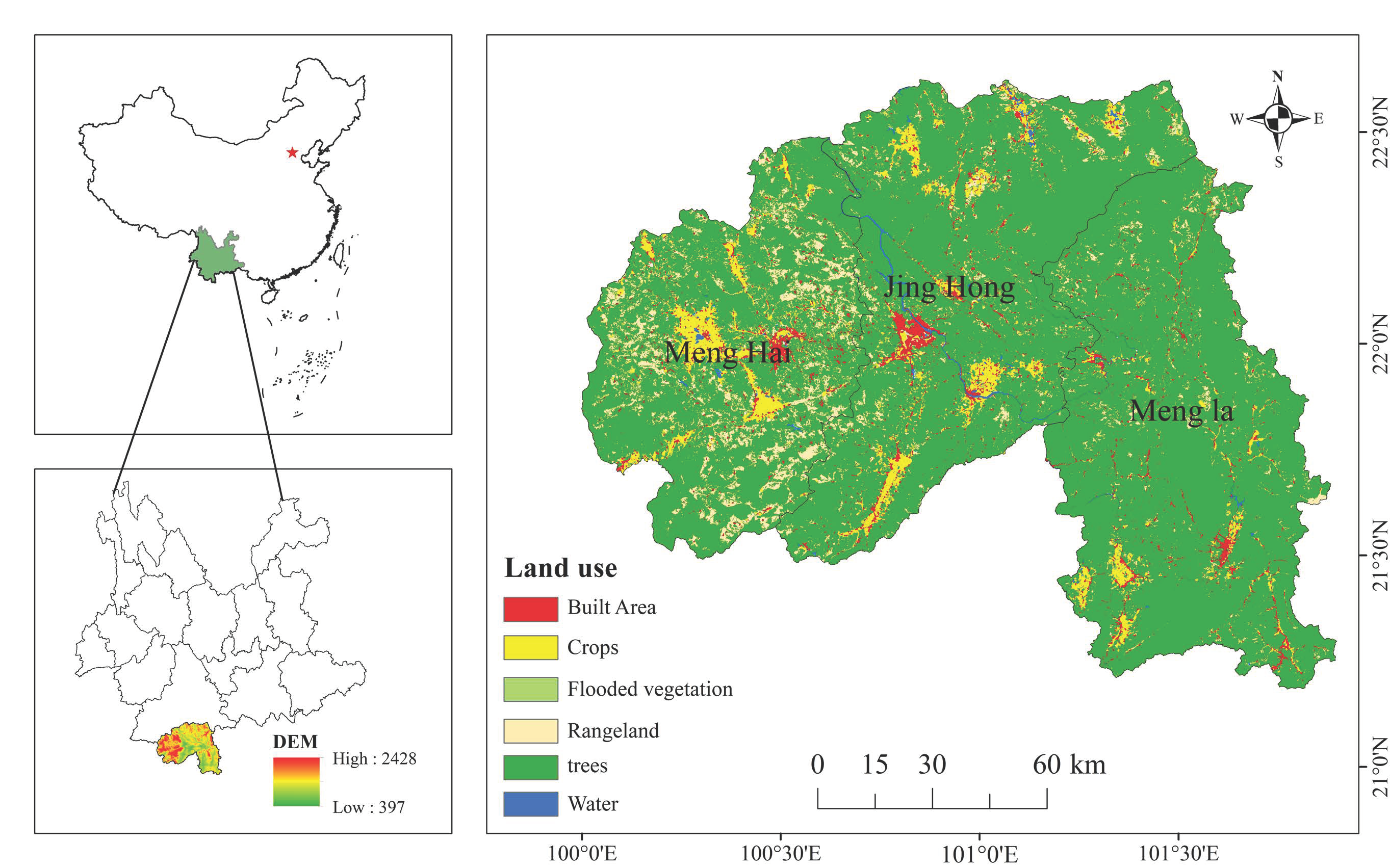
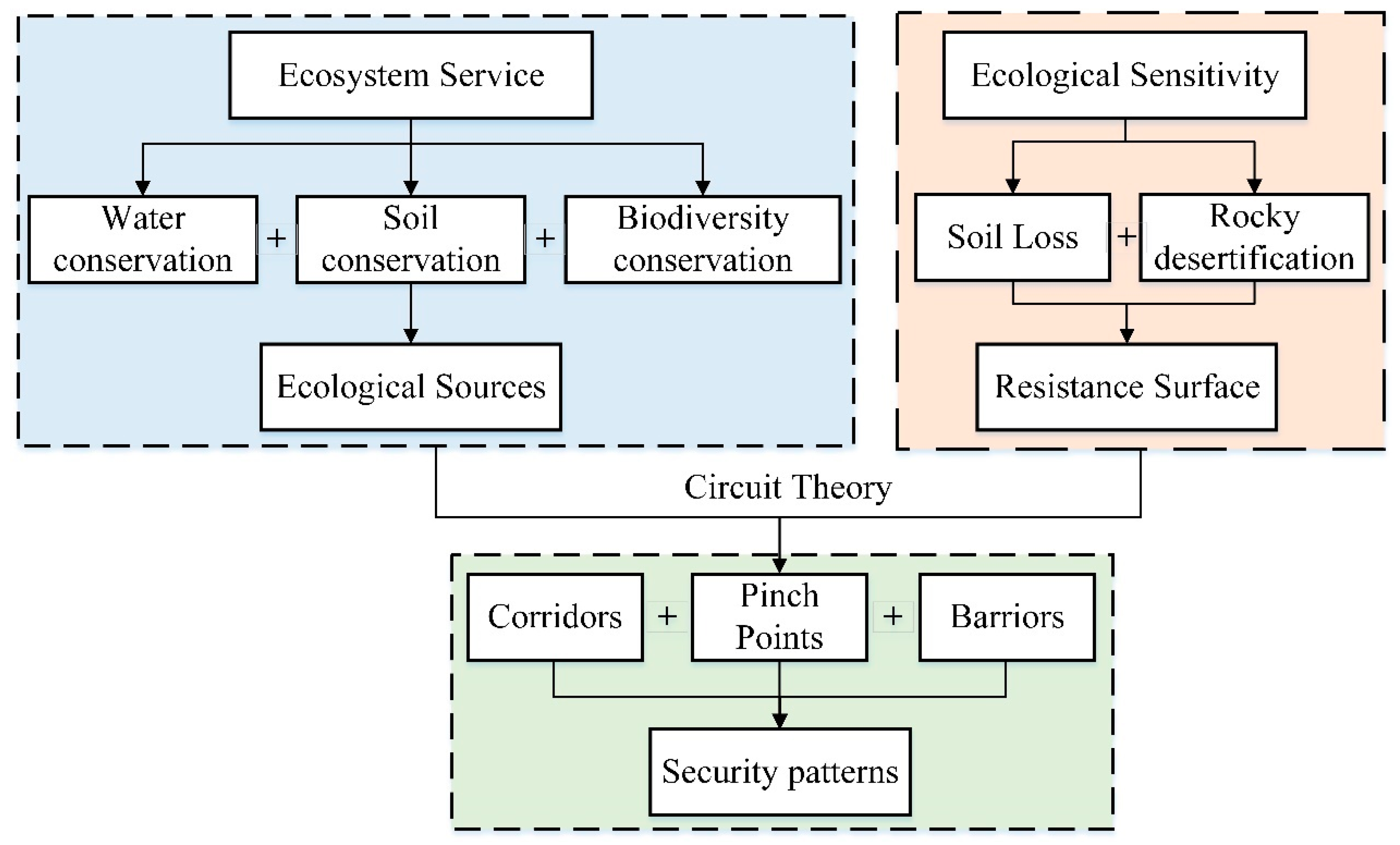
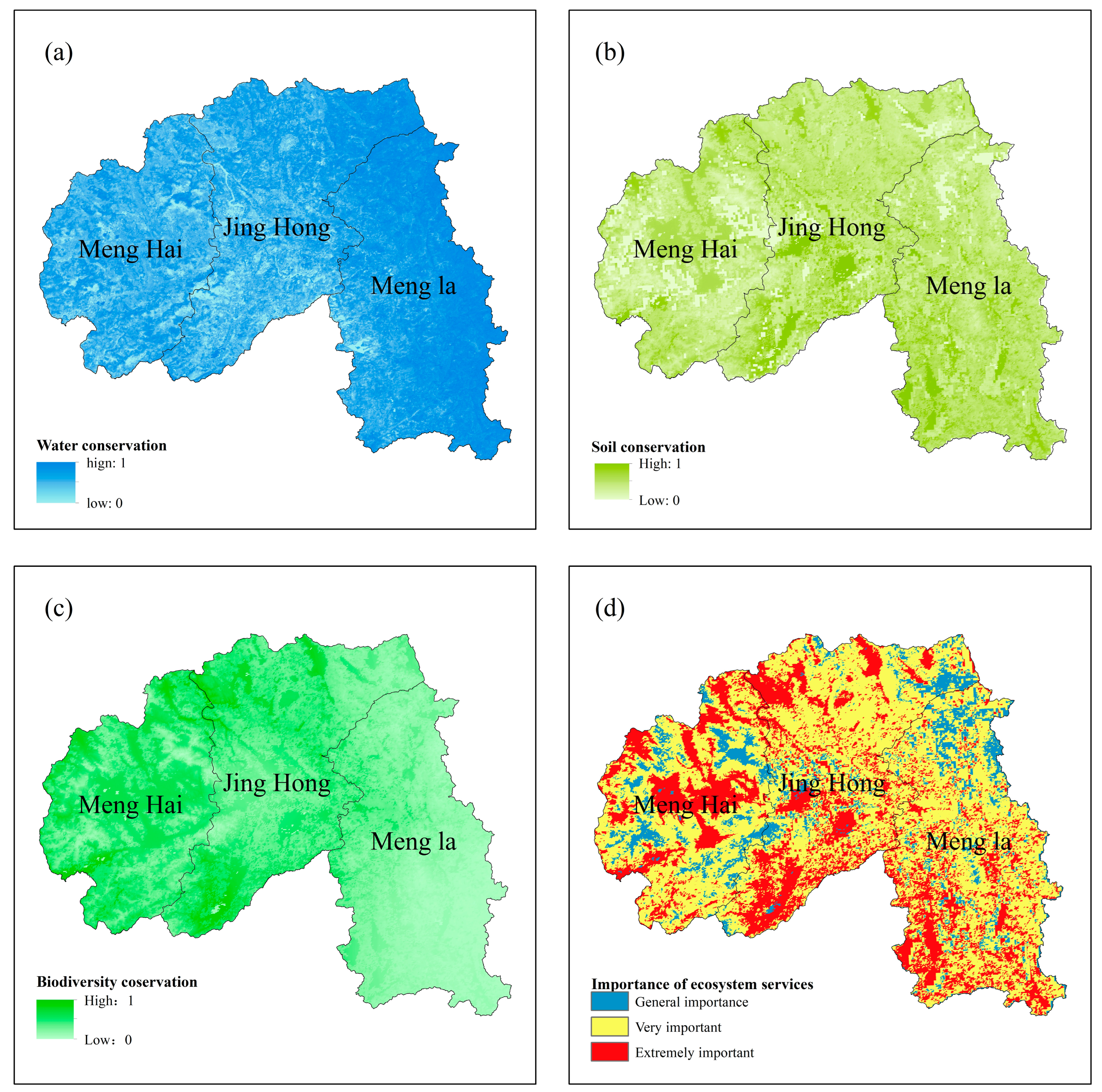


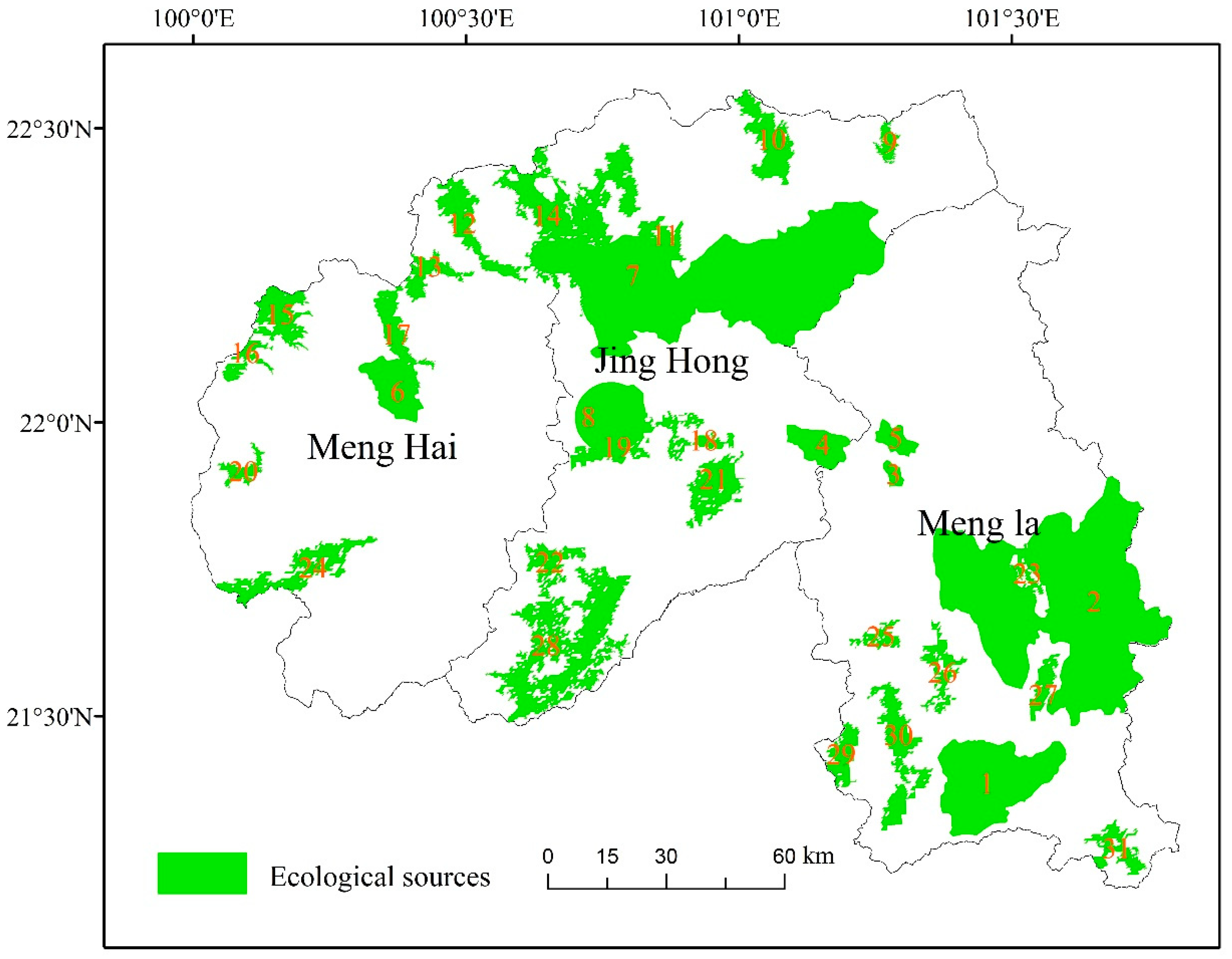
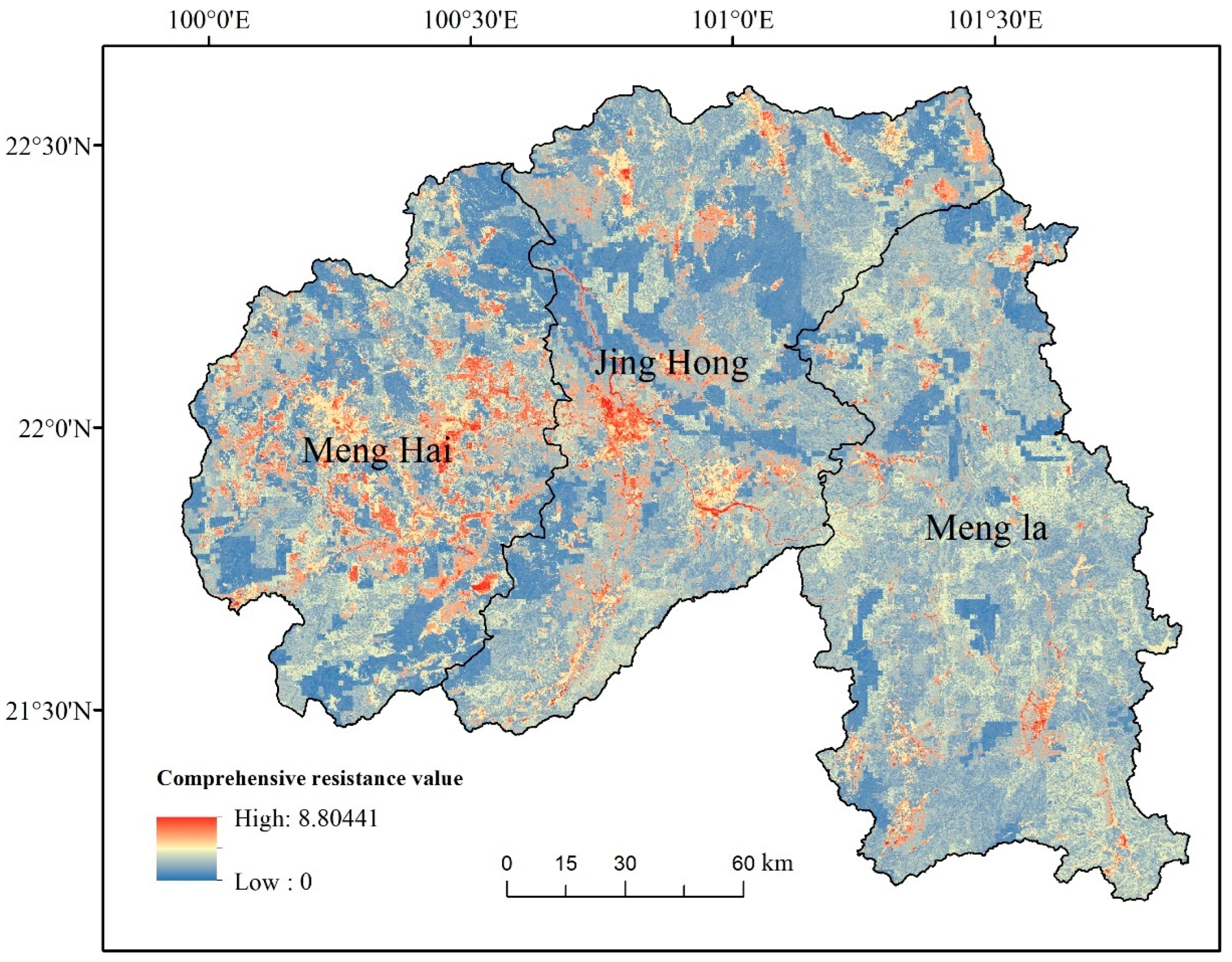
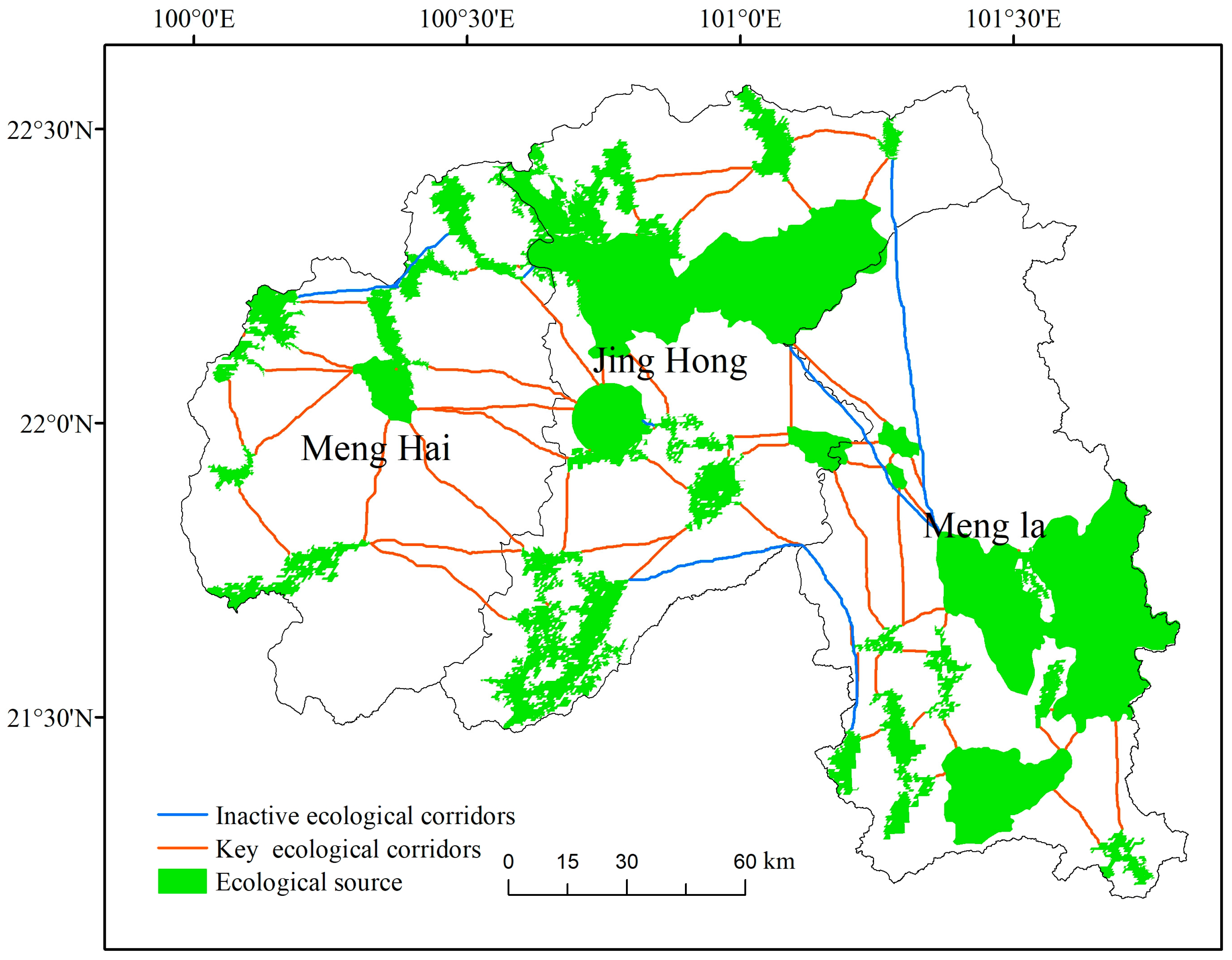

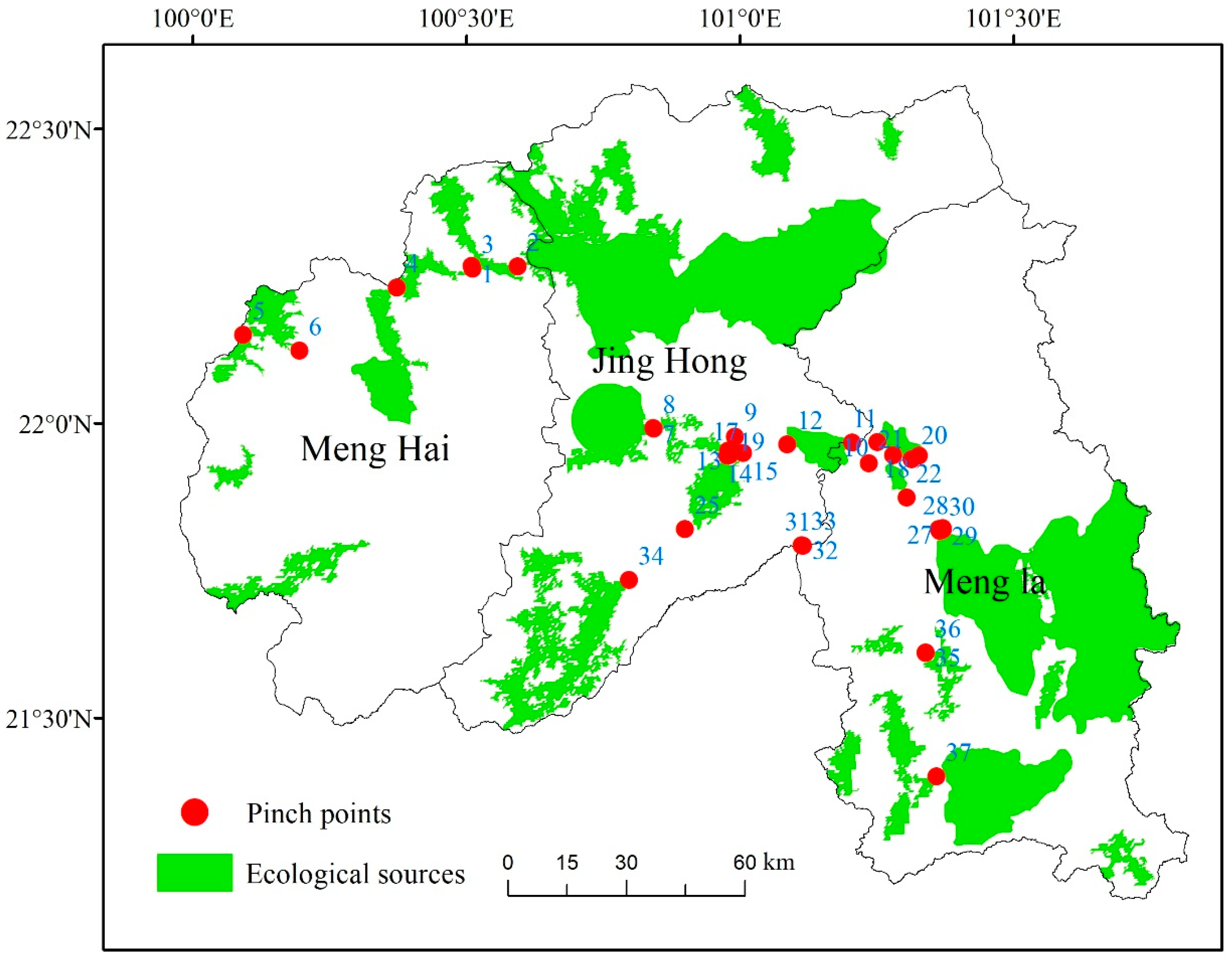

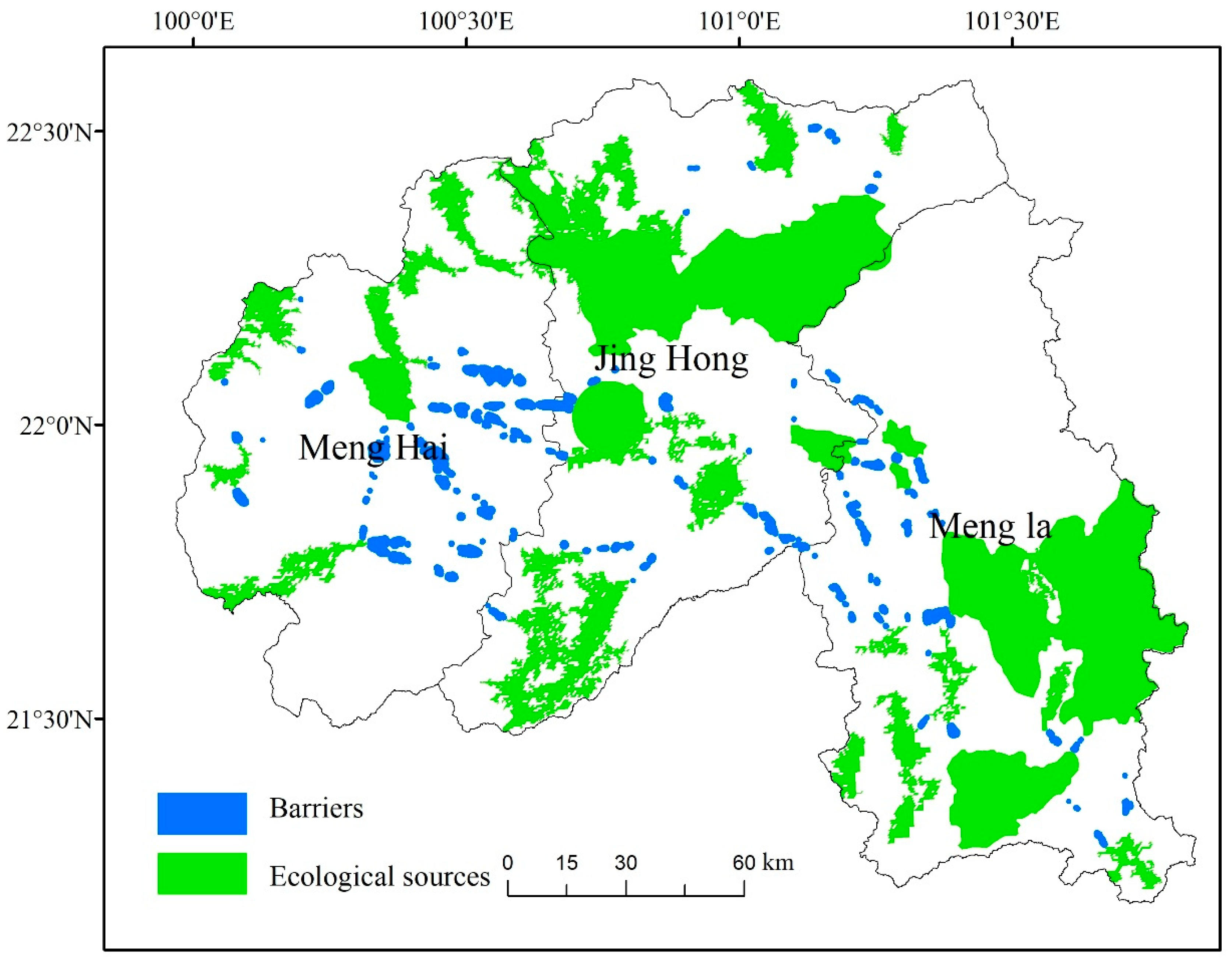
| Term | Unit | Ecological Interpretation |
|---|---|---|
| Resistance (R) | Ohm | Similar to the concept of landscape resistance, the greater the electrical resistance, the stronger the hindrance to species movement (migration or dispersal). |
| Conductance (G) | Siemens | The reciprocal of electrical resistance, similar to habitat permeability, the greater the electrical conductivity, the more favorable it is for species movement (migration or dispersal). |
| Effective resistance () | Ohm | The measurement index for the degree of isolation between two nodes or two pixels in raster data, wherein the effective electrical resistance decreases as the connectivity path between nodes or pixels increases. |
| Effective conductance () | Siemens | The measurement index for the connectivity between two nodes or two pixels in raster data, wherein it increases as the available paths between nodes or pixels increase. |
| Current (I) | Ampere | This reflects the net number of times random walkers pass through corresponding nodes or paths before reaching the target habitat, which is used to predict the net migration probability of species through the corresponding nodes or paths and, thus, predict areas with higher levels of connectivity. |
| Voltage (V) | Volt | The measurement index of the probability for a random walker to leave any node (or pixel) and successfully reach a given target node (or pixel) (i.e., the probability of successful diffusion). |
| Cities | General Important (km2) | Percentage (%) | Very Important (km2) | Percentage (%) | Extremely Important (km2) | Percentage (%) |
|---|---|---|---|---|---|---|
| MengHai | 2147.5 | 29.23 | 2566.529 | 30.50 | 651.6576 | 19.53 |
| JingHong | 2686.23 | 36.57 | 2637.918 | 31.37 | 1539.788 | 46.15 |
| Mengla | 2511.931 | 34.20 | 3206.841 | 38.13 | 1145.093 | 34.32 |
| All | 7345.661 | - | 8411.283 | - | 3336.5386 | - |
| Cities | Low Sensitity (km2) | Percentage (%) | Moderate Sensitity (km2) | Percentage (%) | High Sensitity (km2) | Percentage (%) |
|---|---|---|---|---|---|---|
| MengHai | 2753.635 | 26.88 | 1918.915 | 26.44 | 686.3409 | 43.53 |
| JingHong | 3918.156 | 38.25 | 2320.914 | 31.98 | 621.2538 | 39.40 |
| Mengla | 3571.212 | 34.87 | 3018.055 | 41.58 | 269.0766 | 17.06 |
| All | 10,243.003 | - | 7257.884 | - | 1576.6713 | - |
Disclaimer/Publisher’s Note: The statements, opinions and data contained in all publications are solely those of the individual author(s) and contributor(s) and not of MDPI and/or the editor(s). MDPI and/or the editor(s) disclaim responsibility for any injury to people or property resulting from any ideas, methods, instructions or products referred to in the content. |
© 2024 by the authors. Licensee MDPI, Basel, Switzerland. This article is an open access article distributed under the terms and conditions of the Creative Commons Attribution (CC BY) license (https://creativecommons.org/licenses/by/4.0/).
Share and Cite
Yan, M.; Duan, J.; Li, Y.; Yu, Y.; Wang, Y.; Zhang, J.; Qiu, Y. Construction of the Ecological Security Pattern in Xishuangbanna Tropical Rainforest Based on Circuit Theory. Sustainability 2024, 16, 3290. https://doi.org/10.3390/su16083290
Yan M, Duan J, Li Y, Yu Y, Wang Y, Zhang J, Qiu Y. Construction of the Ecological Security Pattern in Xishuangbanna Tropical Rainforest Based on Circuit Theory. Sustainability. 2024; 16(8):3290. https://doi.org/10.3390/su16083290
Chicago/Turabian StyleYan, Mengmeng, Jilin Duan, Yubin Li, Yang Yu, Yu Wang, Jiawei Zhang, and Yu Qiu. 2024. "Construction of the Ecological Security Pattern in Xishuangbanna Tropical Rainforest Based on Circuit Theory" Sustainability 16, no. 8: 3290. https://doi.org/10.3390/su16083290





